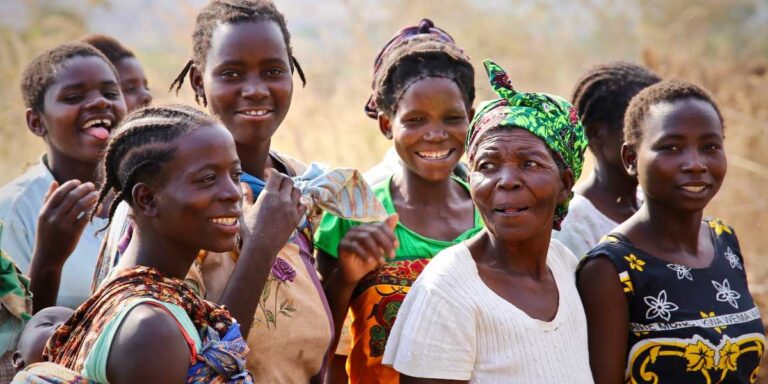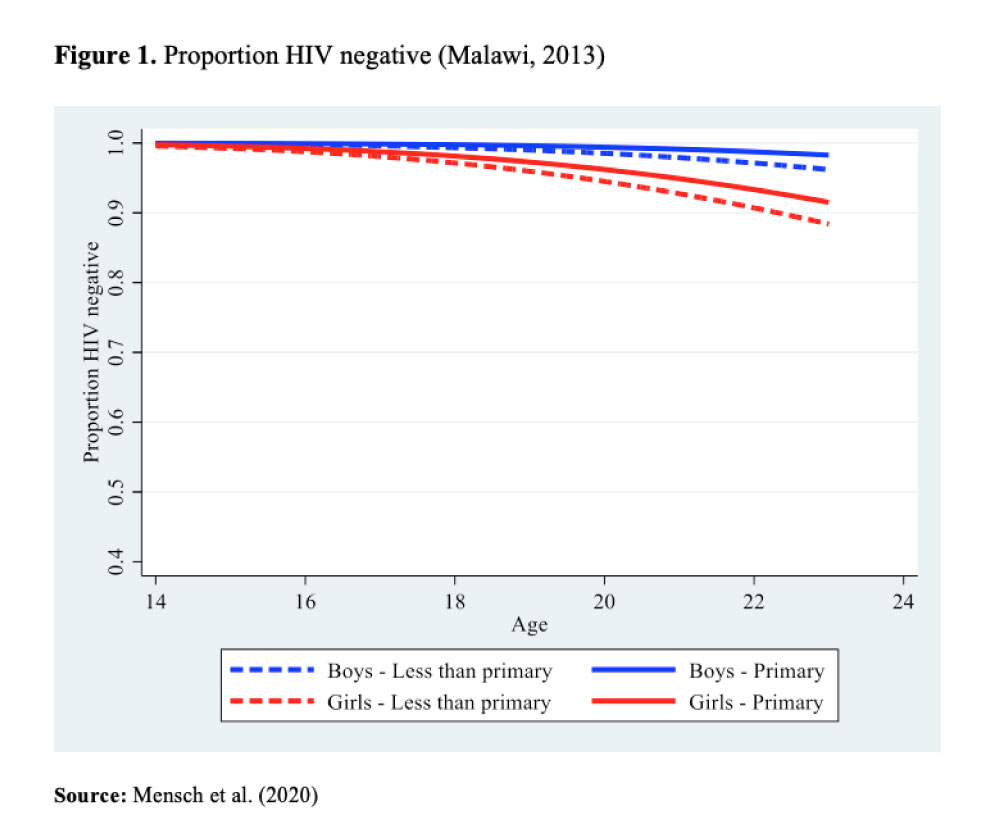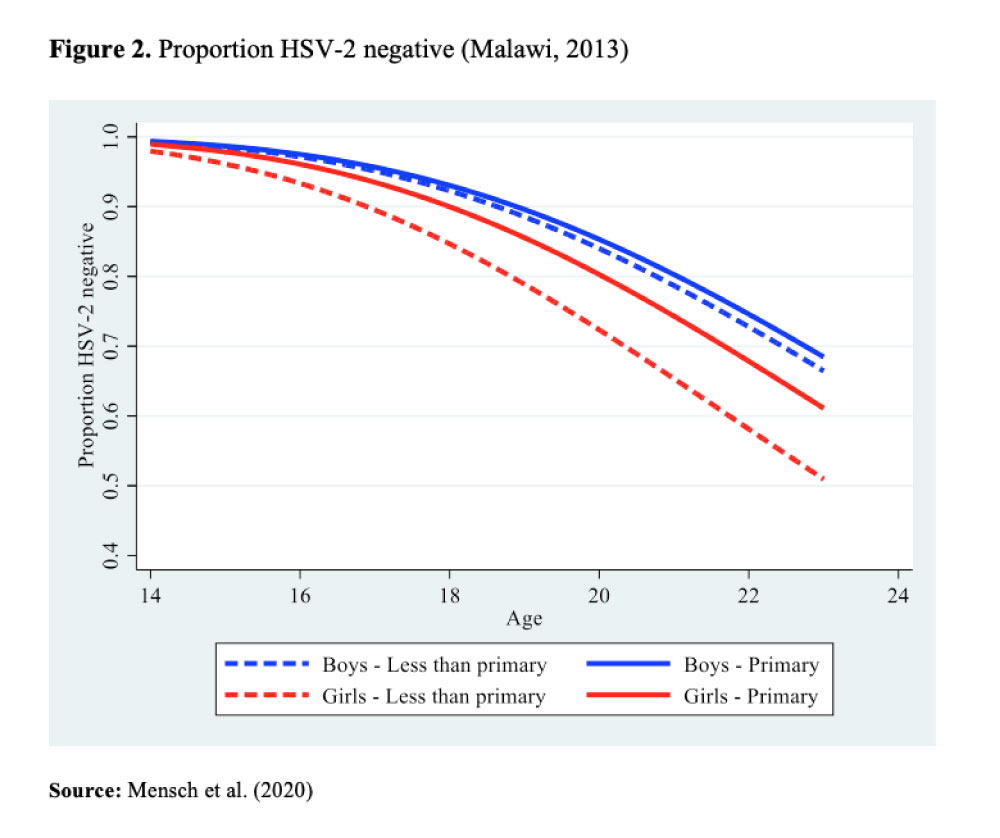Education and sexually transmitted infections among Malawian adolescents

Barbara S. Mensch, Monica Grant and Erica Soler-Hampejsek estimate the effect of enrolment, grade attainment, and skills on herpes and HIV among Malawian adolescents. Grade attained is significantly associated with lower rates of both sexually transmitted infections among girls, and negatively associated with herpes among boys. Encouraging grade progression in high-prevalence settings could reduce or postpone acquisition of STIs.
In developing countries, as elsewhere, the better educated are healthier than their less educated counterparts. There is a strong association between educational attainment and lower maternal, infant, and child mortality. School challenges traditional beliefs about disease and folk remedies and transmits knowledge about behaviours that promote health. In addition, education develops women’s autonomy by improving their status within the family, enabling them to act on health knowledge and increase their utilization of health services. Furthermore, individuals who invest in their education have a stronger incentive to protect their health because of greater expected returns in the future.
Schooling and sexually transmitted infections (STIs)
By extrapolation, these same mechanisms should lead to lower rates of sexually transmitted infections (STIs) among those with more schooling. Yet, since the onset of the AIDS epidemic, the association between educational attainment and HIV in sub-Saharan Africa has varied across space and time. In the early 1990s, HIV prevalence was higher among the better educated who were more mobile and urbanized, and had greater disposable income, characteristics associated with having more sexual partners, extramarital relationships, and delayed marriage. As the epidemic matured and information disseminated about the cause of HIV and the ways to reduce risk, this association disappeared or reversed, in part because those with more schooling were better able to respond effectively (de Walque et al. 2005; Hargreaves, Bonell, et al. 2008).
While the association between educational attainment and STIs among adults has been studied widely, less attention has been given to adolescents. Yet, the younger one is when HIV is acquired, the greater the potential to transmit infection. Because access to testing and treatment is considerably lower among young people, viral suppression is less likely, with consequences for the control of the epidemic (Wong et al. 2017), especially in sub-Saharan Africa where three out of four new infections are among girls aged 15-19 (UNAIDS 2018). While overall AIDS-related deaths globally have declined by over 50% since 2004, among adolescents they have increased by a similar percentage (UNAIDS 2016, 2018).
Adolescents in Malawi
Using data from the Malawi Schooling and Adolescent Study, a six-year longitudinal study of young people ages 14-17 when first interviewed in 2007, we investigated the association between adolescent schooling — school enrolment, grade attainment, numeracy and literacy in the local language — and subsequent infection with HIV and genital herpes, HSV-2 (Mensch et al. 2020). While HSV-2 is considerably more prevalent than HIV during adolescence, it increases the risk of HIV transmission even among those who are asymptomatic; thus, prevention of HSV-2 has consequences for public health, especially in countries where suppressive therapy is not available.
Why consider the distinct contributions of school enrolment, grade attainment, and academic skills? Doing so provides a more precise understanding of the potential protective effects of schooling. Social norms that frame sexual activity and school enrolment as incompatible for girls may delay sexual debut and discourage sexual activity. Although the age range we consider is narrow, there is considerable variability among students of the same age due to late school entry, grade repetition, and intermittent dropout. For example, among those in standard (grade) 8 at baseline in 2007, 19% were 14 years old, 33% were 15, 37% were 16 and 11% were 17. While theoretically those who have higher grade attainment should be more skilled, the expansion of school enrolment and grade attainment in sub-Saharan Africa has been associated with poor learning (Kremer et al. 2013). In Malawi, following implementation of the free primary education policy in 1994, enrolment increased from 1.9 to 2.9 million students in one year, but learning outcomes and exam scores have worsened (Grant 2015).
High prevalence of STIs among Malawian adolescents (but school helps)
At the time of first STI testing in 2010 at ages 17-20, 13.4% of respondents tested positive for HSV-2. An additional 8.5% had seroconverted by 2013 when aged 20-23. Both initial infection rates and seroconversion were significantly higher for young women than for men: 30% of female respondents vs. 18% of male respondents were HSV-2 positive in 2013. Our estimates indicate that by age 23, more than 30% of men and almost 45% of women would be infected with HSV-2.
Less than 2% of all respondents were HIV-positive the first time they were tested in 2010. In 2013, 6.1% of young women and 1.3% of young men were HIV-positive. Our estimates project that by age 23, almost 2% of men and more than 8% of women would be infected with HIV.
Figures 1 and 2 show HIV and HSV-2 survival curves by level of education in 2013; those who completed primary school are less likely to be infected. In models that control for current school enrolment, parental education, ethnicity, community prevalence, and orphanhood status, grade attainment is inversely associated with both HSV-2 and HIV for girls, and with HSV-2 for boys. Each additional grade attained is associated with a 7.0% lower hazard of HSV-2 infection among girls and an 8.6% lower hazard among boys, and each additional grade attained is associated with a 10.6-14.0% lower hazard of HIV infection among girls.


No significant associations are observed between academic skills or school enrolment and infection in models with the full set of education variables, indicating that it is progress through school that matters most for postponing HIV and HSV-2 acquisition among young people. Notably, unlike for girls, the effect of grade attainment is not robust to different model specifications for boys for HSV-2 and never significant for HIV, indicating that schooling is less important for STI prevention among boys than it is for girls.
What is the role of school, really?
How do we interpret the effect of grade attainment? Two effects may be operating.
- Adolescents who continue to progress to higher grades may be more ambitious, better behaved in school, more studious, less likely to be absent, and have greater educational expectations, attributes likely associated with less (risky) sexual activity, particularly for girls, for whom engaging in sexual activity while enrolled in school is potentially more consequential than it is for boys.
- It may also be that progression through school is a self-perpetuating process, particularly for girls who encounter competing roles at puberty. The further a student goes in school, the further she may want to go, and the more she may identify as a student rather than a young woman on the marriage market.
That literacy and numeracy are not significant in our models does not mean that skill acquisition is unimportant for longer-term health outcomes or that those with more education are not more knowledgeable about HIV prevention and better equipped to act on that knowledge. Those with higher grade attainment may possess greater non-cognitive skills and have acquired the interpersonal and communication competencies necessary to navigate health institutions and acquire targeted knowledge. They may also be more likely to understand ‘safe sex’ messages.
As is the case for other countries of sub-Saharan Africa where school enrolment grew rapidly after the abolition of primary school fees, there is a ‘learning crisis’ in Malawi. Yet, the results presented here from two districts in the Southern region of the country provide evidence that even in a setting with deficient school quality and poor learning outcomes, the further adolescents progress through school, the less likely they are to become infected with STIs. In high-prevalence settings in sub-Saharan Africa, efforts to encourage students, particularly girls, to stay on track and to continue through school could well reduce, or at least postpone, acquisition of STIs.
References
de Walque, Damien, Jessica S. Nikiyingi-Miiro, June Busingve, & Jimmy A. Whitworth. 2005. Changing association between schooling levels and HIV-1 infection over 11 years in a rural population cohort in south-west Uganda. Tropical Medicine and International Health, 10(10): 993-1001.
Grant, Monica J. 2015. “The Demographic Promise of Expanded Female Education: Trends inthe Timing of First Birth in Malawi.” Population and Development Review. 41(3): 409-438.
Hargreaves, James R, Christopher P Bonell, Tania Boler, Delia Boccia, Isolde Birdthistle, Adam Fletcher, Paul M Pronyk, & Judith R Glynn. 2008. Systematic review exploring time trends in the association between educational attainment and risk of HIV infection in sub-Saharan Africa. AIDS, 22(3): 403-414.
Kremer, Michael, Conner Brannen, & Rachel Glennerster. 2013. The challenge of education and learning in the developing world. Science, 340(6130): 297-300.
Mensch, Barbara S., Monica J. Grant, Erica Soler-Hampejsek, Christine A. Kelly, Satvika Chalasani & Paul C. Hewett (2020) Does schooling protect sexual health? The association between three measures of education and STIs among adolescents in Malawi, Population Studies, 74:2, 241-261, DOI: 10.1080/00324728.2019.1656282.
UNAIDS. (2016, 2016). Ending the AIDS epidemic for adolescents with adolescents. Retrieved 11/16/2018, 2018,
UNAIDS. (2018). UNAIDS Fact Sheet – July 2018. Retrieved 11/16/2018, 2018
Wong, Vincent J, Kate R Murray, B Ryan Phelps, Sten H Vermund, & Donna R McCarraher. 2017. Adolescents, young people, and the 90–90–90 goals: a call to improve HIV testing and linkage to treatment. AIDS (London, England), 31(Suppl 3): S191.